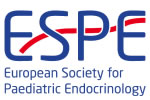hrp0092fc2.6 | Bone, Growth Plate and Mineral Metabolism Session 1 | ESPE2019
Validation of a New Version of BoneXpert Bone Age in Children with Congenital Adrenal Hyperplasia (CAH), Precocious Puberty (PP), Growth Hormone Deficiency (GHD), Turner Syndrome (TS), and other Short Stature Diagnoses
Thodberg Hans Henrik , Martin David D
hrp0092rfc5.2 | Thyroid | ESPE2019
Ultrasound Features of Multinodular Goiter in DICER1 Syndrome
Niedziela Marek , Muchantef Karl , Foulkes William D
hrp0092p2-138 | Fat, Metabolism and Obesity | ESPE2019
A Rapid Instrument for Diagnosis and Screening of Pediatric Obesity and its Complications: The Neck Circumference
Guercio Nuzio Salvatore , D'Isanto Livio
hrp0086p2-p864 | Syndromes: Mechanisms and Management P2 | ESPE2016
Secretion of Somatostatin and Growth Hormone (GH) in Various Forms of Hereditary Pathology
Muhamedov R.S. , Ibragimova N. Sh. , Dalimova D.
hrp0092p1-370 | GH and IGFs (2) | ESPE2019
Challenges Experienced in Delivering Growth Hormone Therapy in Children's with Prader Willi Syndrome in Birmingham Children's Hospital.
Kollurage D Udeni Anuruddhika , Barrett Tim , Jayamanne B D W , Krone Ruth
hrp0092p3-109 | Fat, Metabolism and Obesity | ESPE2019
Follow-Up Evaluation of Clinical Markers and Inflammatory, Biochemical and Hormonal Profiles in Children with Bodyweight Problems
Ṭaranu Ioana , Bolboacă Sorana D. , Creţ Victoria
hrp0082p3-d2-686 | Bone (1) | ESPE2014
I.V. Zolendronic Acid: Experience of Treatment of Children with Osteogenesis Imperfecta in Indonesia
Pulungan A , Zacharin M , Armstrong K , Soesanti F , Pramesti D L
hrp0084p2-343 | Fat | ESPE2015
Chronodisruption in Obese Children
Saner Christoph , Mullis Primus , Simonetti Giacomo D , Janner Marco
hrp0084p3-1129 | Pituitary | ESPE2015
Thickened Pituitary Stalk with Central Diabetes Insipidus: What Diagnosis?
Merazka Amel , Achir S , Baz O , Foudil D , Mimouni S
hrp0097p1-286 | Fetal, Neonatal Endocrinology and Metabolism | ESPE2023
Aetiology and Outcome of Hypoglycaemia in Young Children
Yean Chai Xin , Guftar Shaikh M. , D. McNeilly Jane



